Tales of the Tape: Breaking down key Week 5 matchups

The game of football is all about matchups. Each week, we will use the Xs and Os to highlight some critical showdowns on the upcoming schedule.
Bills at Lions: A familiar approach
Jim Schwartz would prefer not to blitz.
That was true when Schwartz was roaming the sidelines as Detroit's head coach, and it is still the case now that Schwartz is Buffalo's defensive coordinator. He will make his return to the Motor City in Week 5, as the Bills take on the NFC North-leading Lions.
And if recent history holds, Schwartz will rely on his line to pressure Matthew Stafford while the rest of the defense settles into coverage.
• NFL Week 5 Power Rankings | Best, worst of NFL season's first quarter
Under Schwartz, the Lions blitzed just 115 times last season, a little more than 18 percent of the time a quarterback dropped back to pass, via Pro Football Focus. Only the Jaguars sent extra bodies at the quarterback less frequently. This season, through four games with the Bills, Schwartz has dialed up 35 total blitzes -- a combined 14 the past two weeks, both losses. By contrast, Arizona blitzed 19 times in each its first two games.
The All-22: Steve Smith, other veterans thriving with new teams
"If you're sending those extra guys after the quarterback, you're not going to have extra guys to cover," Schwartz said ahead of Buffalo's 22-10 loss to the Chargers in Week 3, via Syracuse.com. "We have plenty of blitz in our game plan, we have plenty of four-man rush and three-man rush in our game plan. When we do, we just have to execute what's called."
Schwartz can afford to be less aggressive with Buffalo thanks to a line that starts Mario Williams, Marcell Dareus, Kyle Williams and Jerry Hughes. The Bills have 10 sacks this season, despite their limited blitz attempts. (A Lions defense that featured Ndamukong Suh, Nick Fairley, Ziggy Ansah and others provided Schwartz a similar advantage in the past.)
• Challenge your friends and win BIG in our weekly fantasy football game
So what can Stafford expect to see Sunday? Several coverage variations behind a four-man front, for the most part.
Schwartz displayed three separate approaches on three consecutive plays to open the second half in Week 2 against Ryan Tannehill and Miami. The first came with the Dolphins in a three-receiver set and Charles Clay working as an H-back in motion behind Tannehill.
Buffalo countered in 4-3 personnel, a safety dropped down and a Cover-1 look over the top.
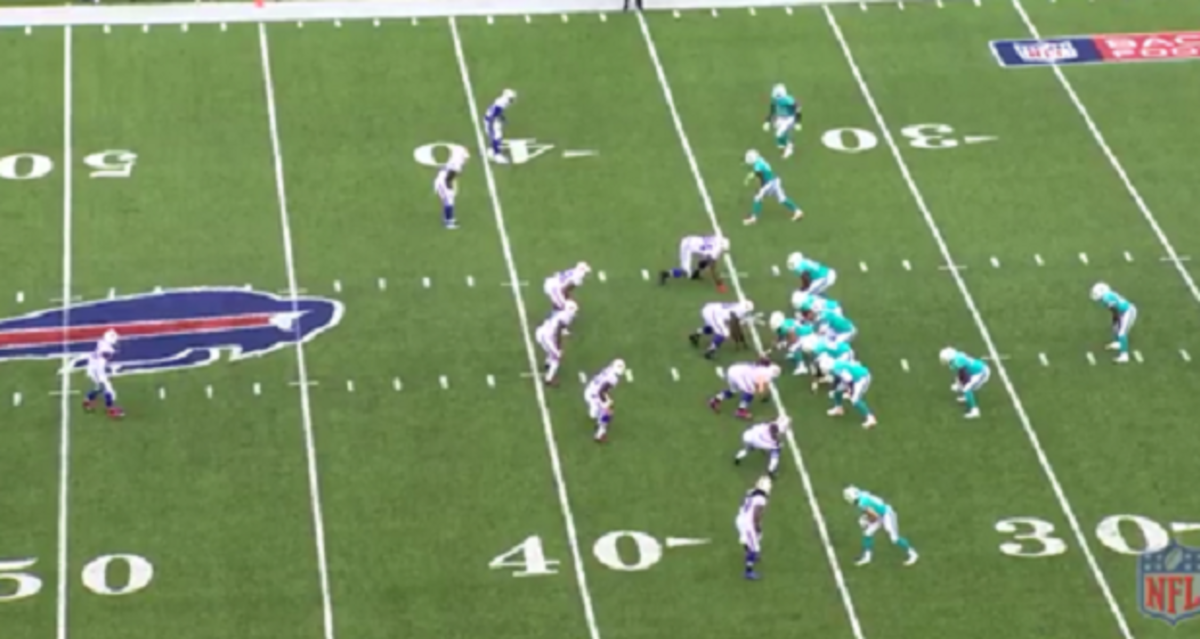
Rather than keeping that deep safety in place, though, Schwartz employed another of his preferred calls: a robber. The safety left his post to break toward the ball, in hopes of jumping a Tannehill pass over the middle.
Which brings us to another element of Schwartz's defense: He's not afraid to leave cornerbacks on an island. It worked here, mainly because Tannehill misread the play and dumped one off to Clay (circled), instead of targeting Mike Wallace near the 46-yard-line.
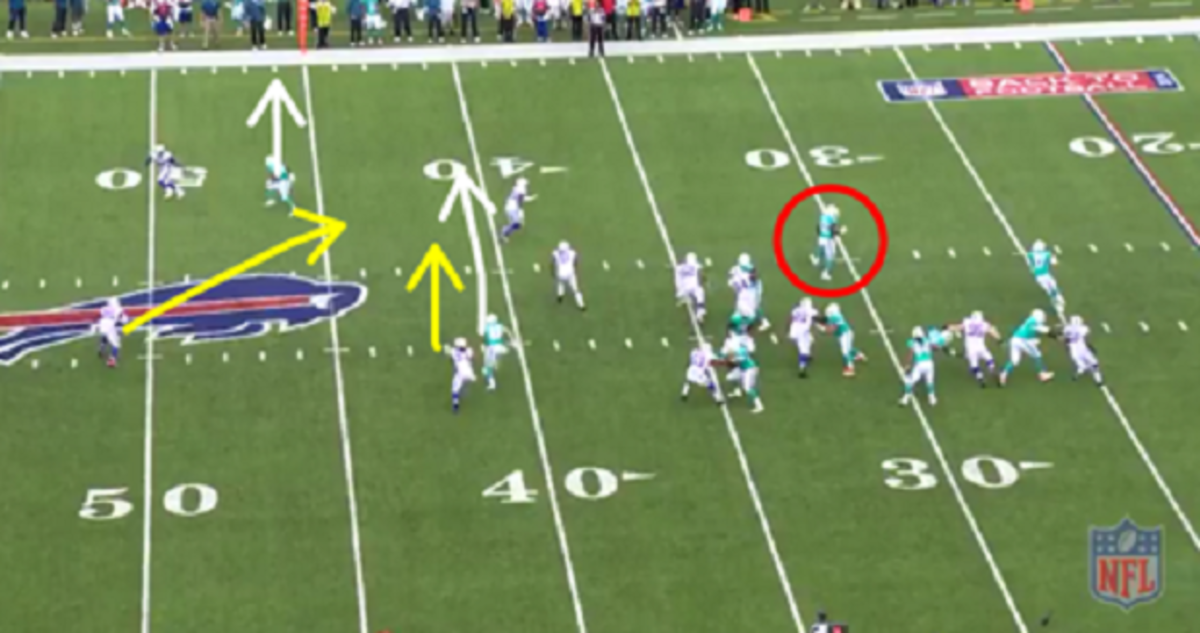
On the next play, a second-and-15, the Bills switched into a nickel look. This time, both safeties flashed that robber coverage, cutting off the middle of the field. Again, the cornerbacks were out on islands wide. The four-man rush/seven-man coverage plan paid off here with a sack.
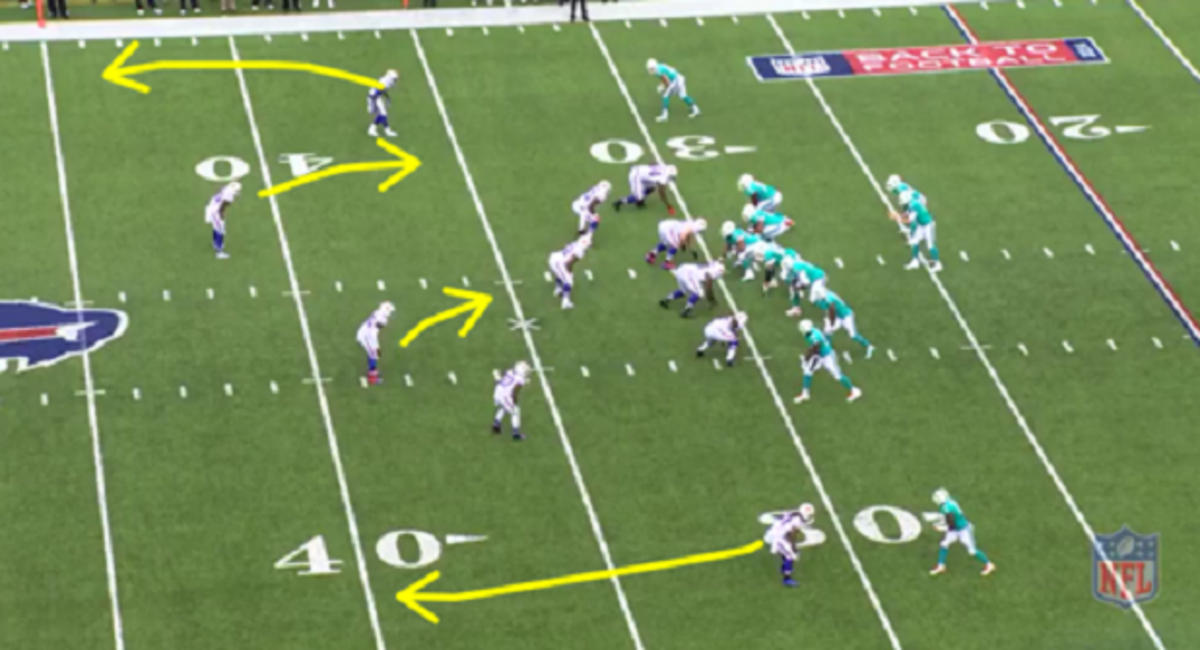
Buffalo came up with another sack of Tannehill on third down after shifting into a Cover-4 umbrella for the third-and-long. Two linebackers and a cornerback were responsible for the short middle.
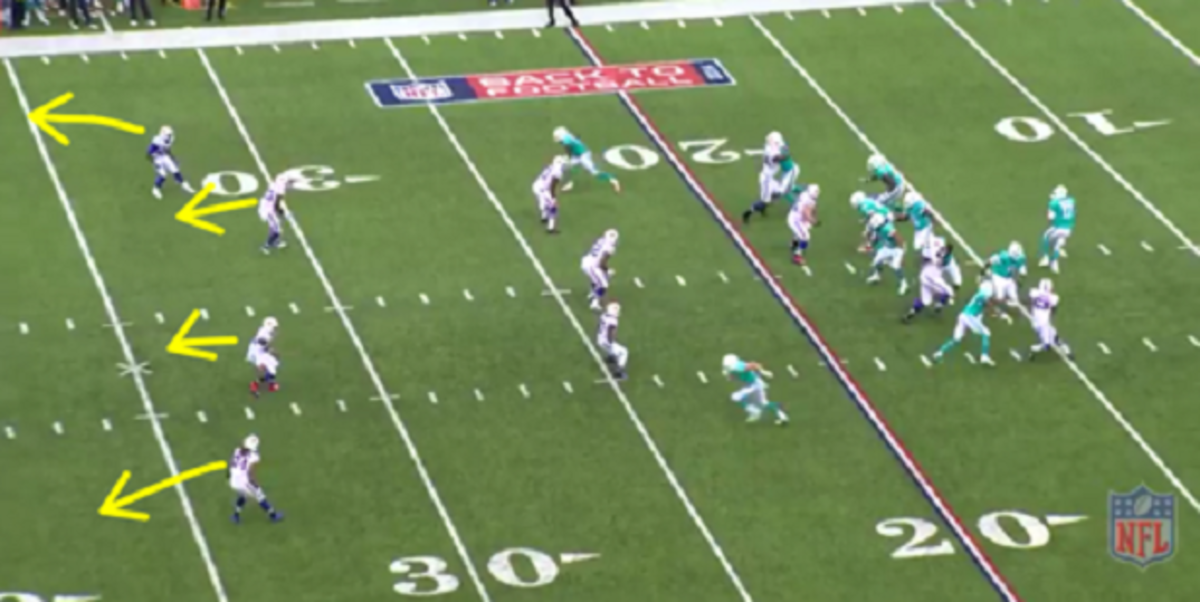
Detroit can be a tricky team to defend in such a manner for a couple of reasons:
1) The Lions often send four or five pass-catchers out, stretching the field both sideline-to-sideline and deep.
2) Stafford is comfortable tossing up 50-50 balls deep, particularly to Calvin Johnson, which could prove costly for Buffalo if Schwartz opts to crash his safeties toward the line.
A couple of examples: The shot below is from Detroit's Week 1 game against the Giants, who rely on a four-man front. The Lions lined up Calvin Johnson to Stafford's left, with trips to the opposite side and Reggie Bush in the backfield. Both Bush over the middle and Golden Tate running a deep post came free for Stafford, who opted instead to throw one up for grabs to Johnson.
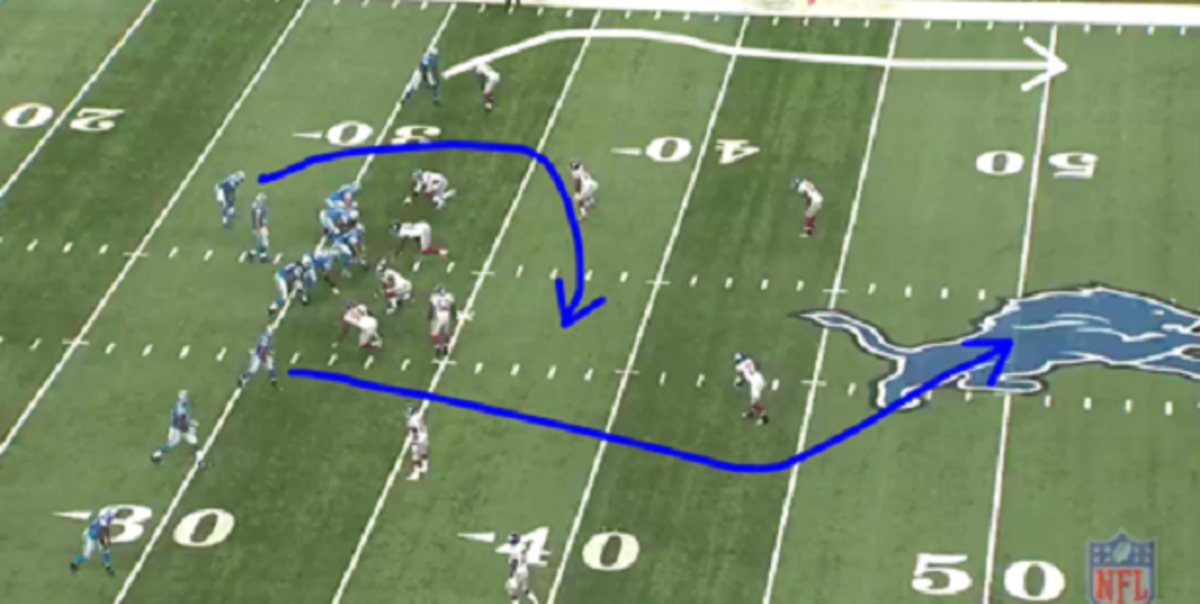
Here's what the coverage looked like as Stafford began to throw, and it circles back to that spacing issue I just mentioned.
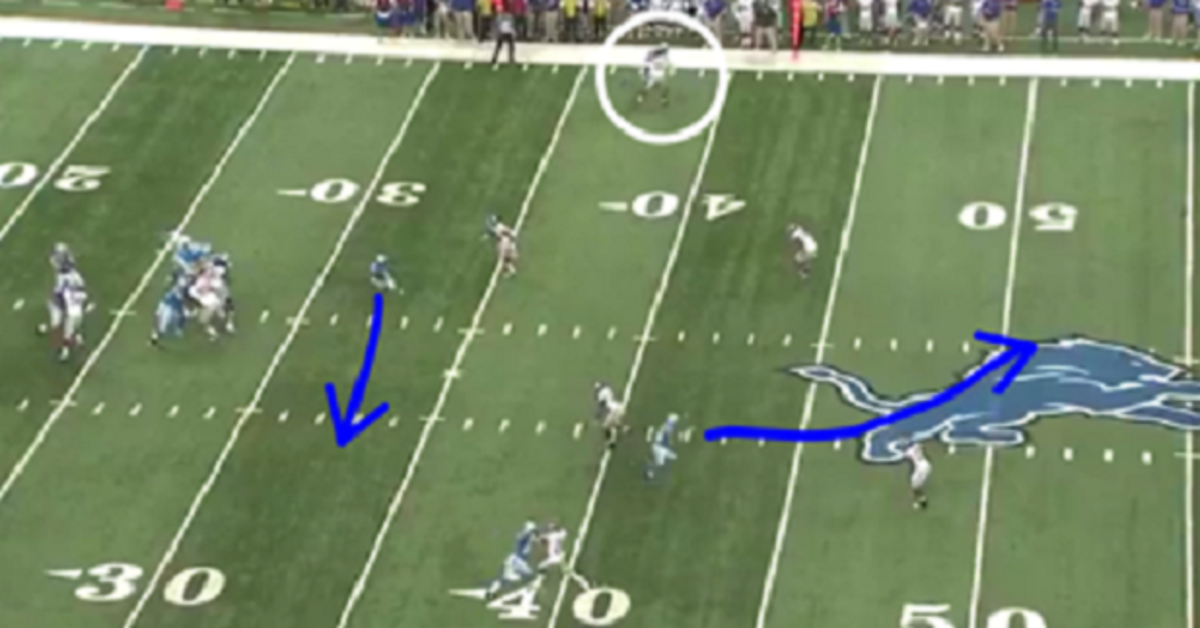
If the pass rush doesn't get home, the Lions' bevy of weapons can leave a defense in no man's land. Stafford could have hit Bush cutting across the middle, giving him a chance in space against linebackers, or waited an extra beat for Tate to break into the open deep.
Fantasy Football Week 5 stat projections
Later in the same drive, Stafford escaped pressure by moving to his right, then hit Johnson for a long touchdown courtesy of a coverage breakdown. But notice where everyone is prior to the pass. Detroit broke two underneath options toward the boundary, Johnson ran a deep out and two other receivers went long.
As a result, the Giants were stretched extremely thin, even with seven defenders covering five guys.
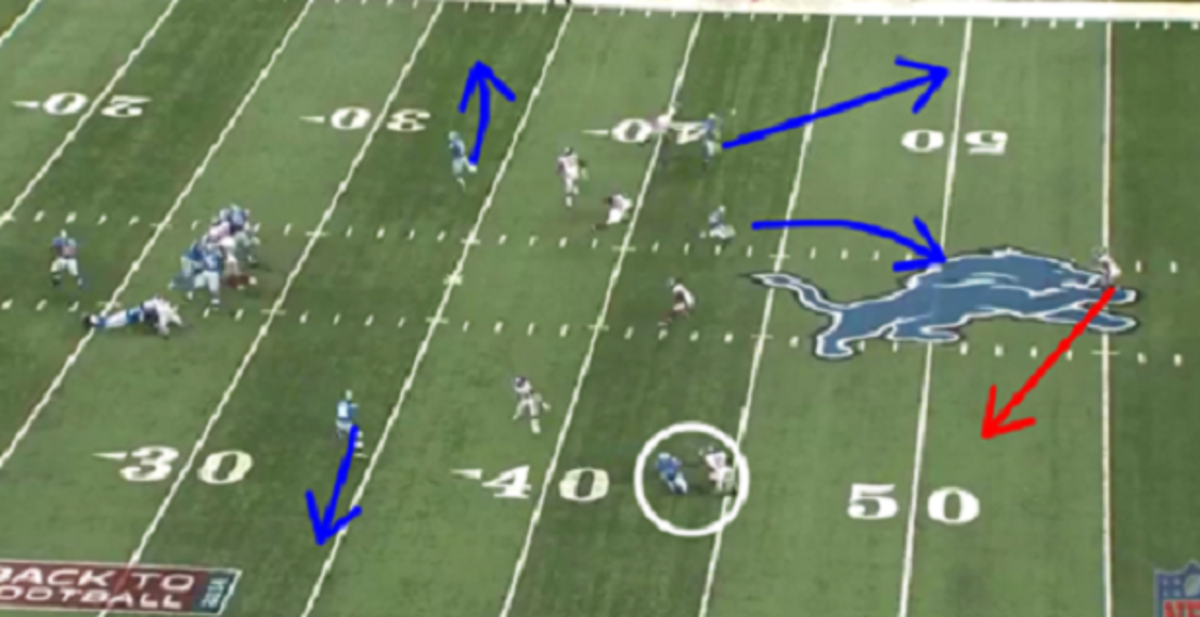
Stafford is not at all opposed to using his running backs in these situations, particularly against man coverage. Below, we see a completion to Bush, who was matched up against Green Bay linebacker A.J. Hawk with no other Packers in the vicinity.
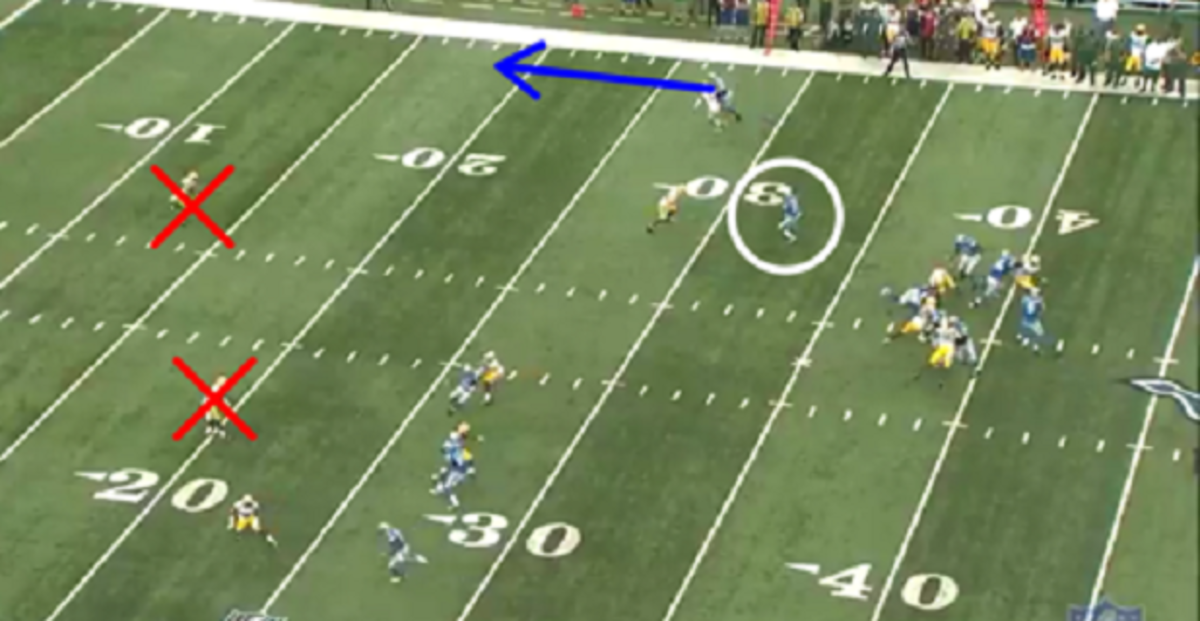
Schwartz wants his defense to produce what it did on an interception of Ryan Fitzpatrick last Sunday. The Texans spread the field with five wide and Schwartz, as usual, rushed just four. But the Bills managed to push the pocket a bit, thereby hurrying Fitzpatrick. He attempted to fire into tight coverage, the ball was swatted at the line and ... interception.
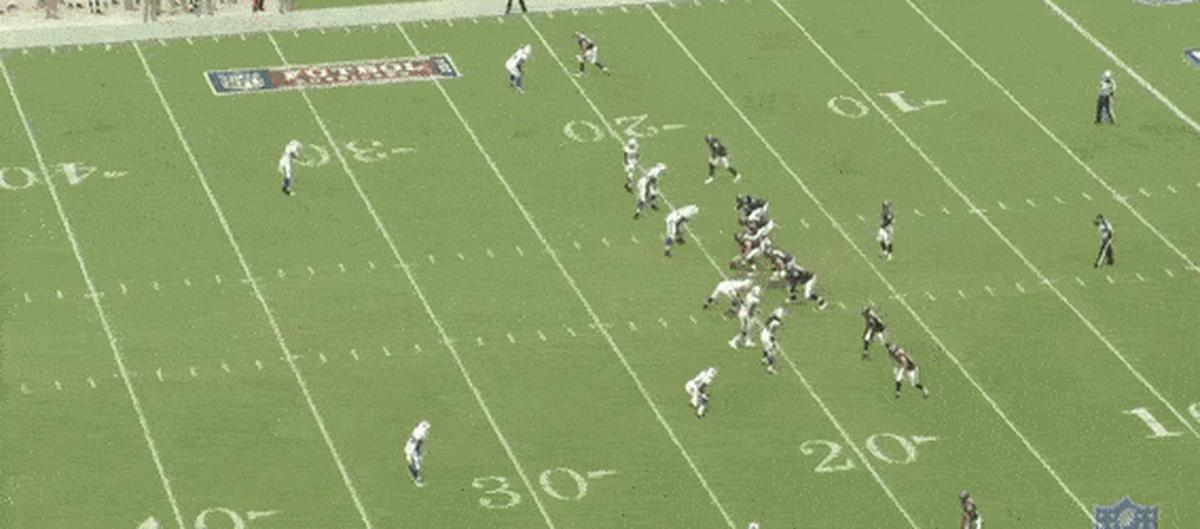
Buffalo has to create a level of discomfort for Stafford. Otherwise, the Lions' quarterback and scheme will open up gaps downfield.
Cowboys at Texans: Watt and Witten
Perhaps the most intriguing personnel matchup of Week 5 will pit Texans superstar defensive end J.J. Watt against Dallas' Tyron Smith, arguably the best left tackle in football at the moment. Because of Smith and the extremely capable run blocking of tight end Jason Witten (ranked No. 1 in that category among tight ends by Pro Football Focus), Dallas may be one of the few teams that can go right at Watt on occasion.
Of course, Watt is a singular talent, so even a Smith/Witten combo or a perfectly executed game plan might run into trouble. The Bills found out last week what a mistake it can be to push toward Watt's side on the ground. They ran left of their center eight times in Week 4 for all of 26 yards.
That's Watt circled below.
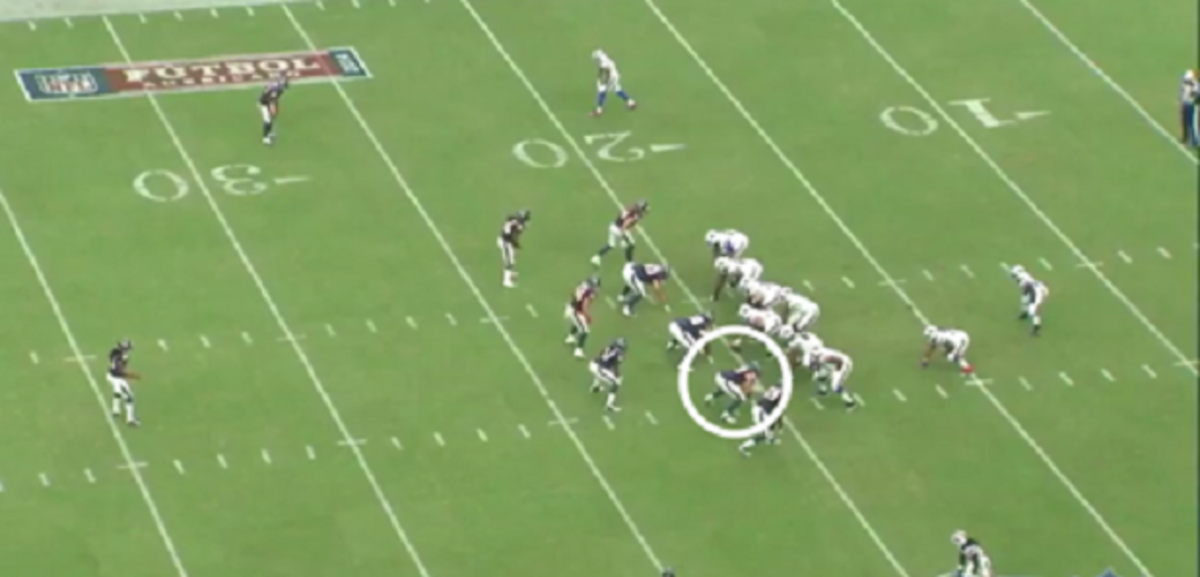
Left guard Cyril Richardson was primarily responsible for Watt on the play, but he had initial help from left tackle Cordy Glenn. Two on one at the snap. Advantage: Bills, right?
Ehhhhhhh ...
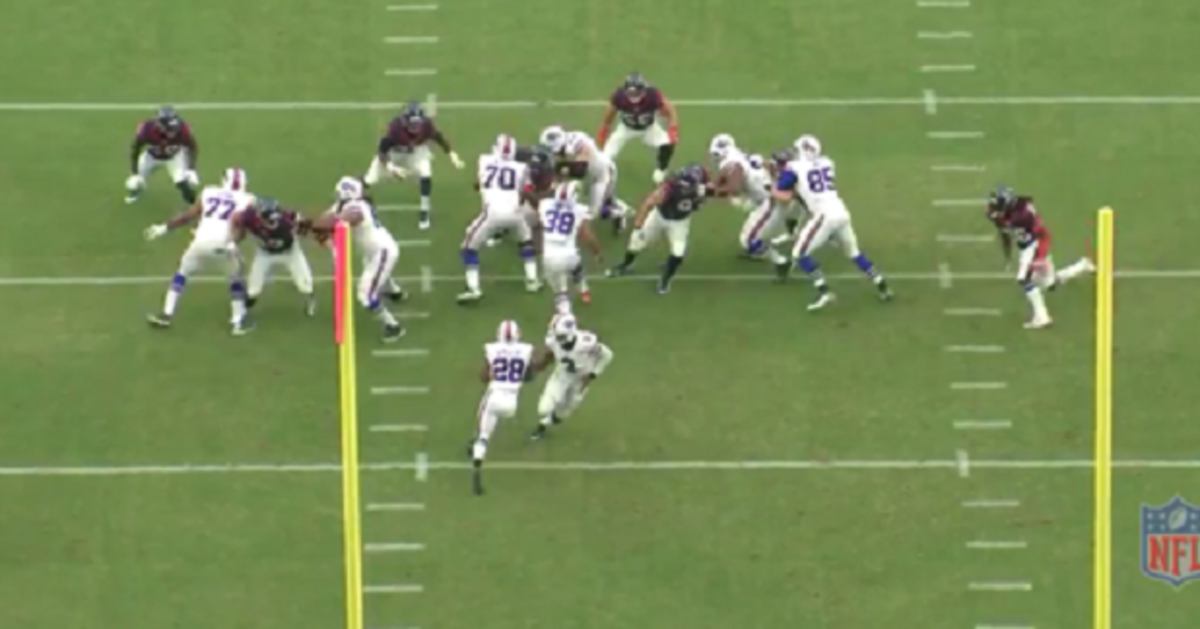
Watt was through the line by the time EJ Manuel handed off, then circled back around Richardson to assist on the tackle two yards downfield.
Dallas, however, had success with DeMarco Murray rushing to his left Sunday night against New Orleans -- and that's a Saints defense featuring rising star Cam Jordan at right end. On the play here, Smith took Jordan at the snap, then Witten down-blocked into the defensive end, pushing him away from the edge. Murray ran right into the gap.

A better look at the Smith/Witten combo block on Jordan, which drives the Saints lineman away from his spot.
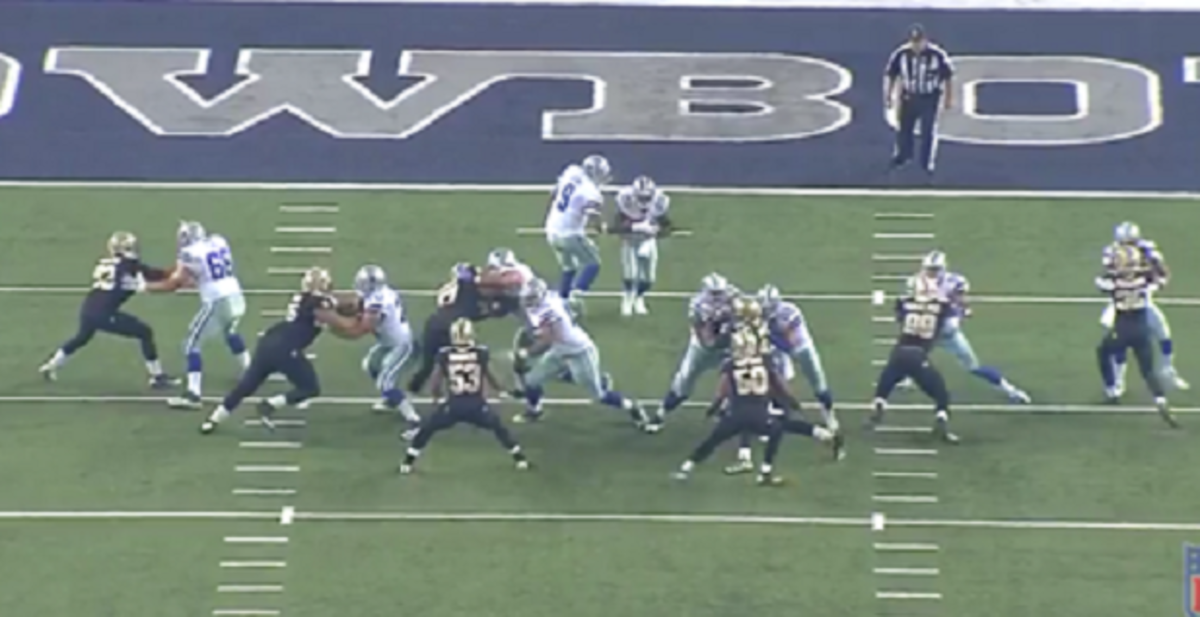
The Cowboys have agility in numerous spots on the line, in addition to Witten at tight end. Murray had another solid run to his left later with guard Ronald Leary pushing out to Jordan in a zone-blocking look. Smith chipped Jordan's outside shoulder to help slow him down, then moved onto the second level, while Witten drove toward the boundary.
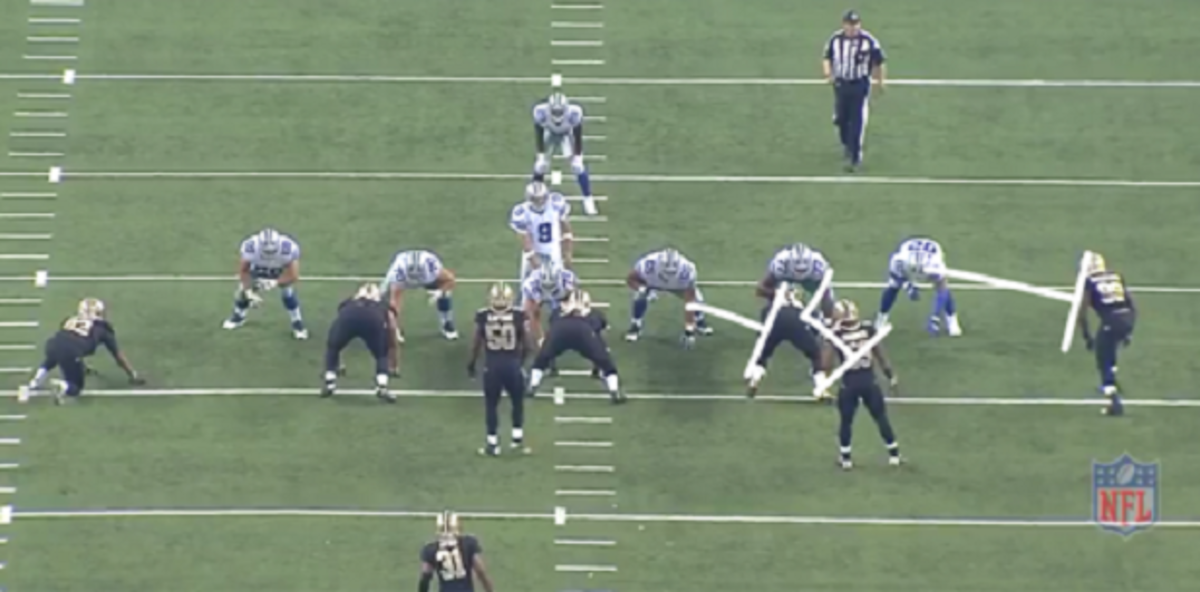
With his line able to get the defense moving horizontally, Murray found a gap and cut upfield.

Watt's dominance against Smith, Witten and the Cowboys' run game might be as good as it gets in the NFL this season.
Rams at Eagles: Drawing the line
A quick note here on LeSean McCoy, who is averaging a paltry 2.7 yards per carry this season and now faces the Rams' athletic front: McCoy may be the least to blame for his slow start.
One play from Philadelphia's loss to San Francisco to show why I say that: a zone-read handoff by Nick Foles to McCoy, which was called well because it had McCoy running away from a blitz off the edge.
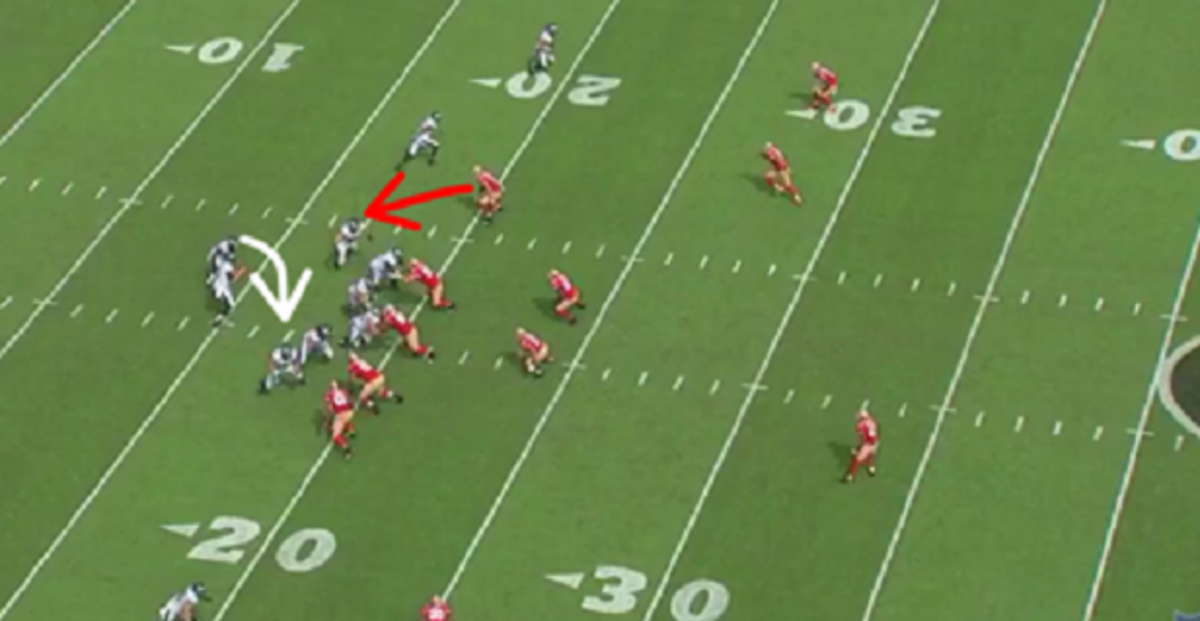
When the quarterback and running back were at the hand-off mesh point, everything appeared to be perfectly aligned. The Eagles had a blocker releasing to take on Patrick Willis (52), another to handle Michael Wilhoite (57) and Dan Skuta, the linebacker blitzing, was frozen in case Foles ran.
McCoy had two potential lanes developing -- up the gut or off-tackle.
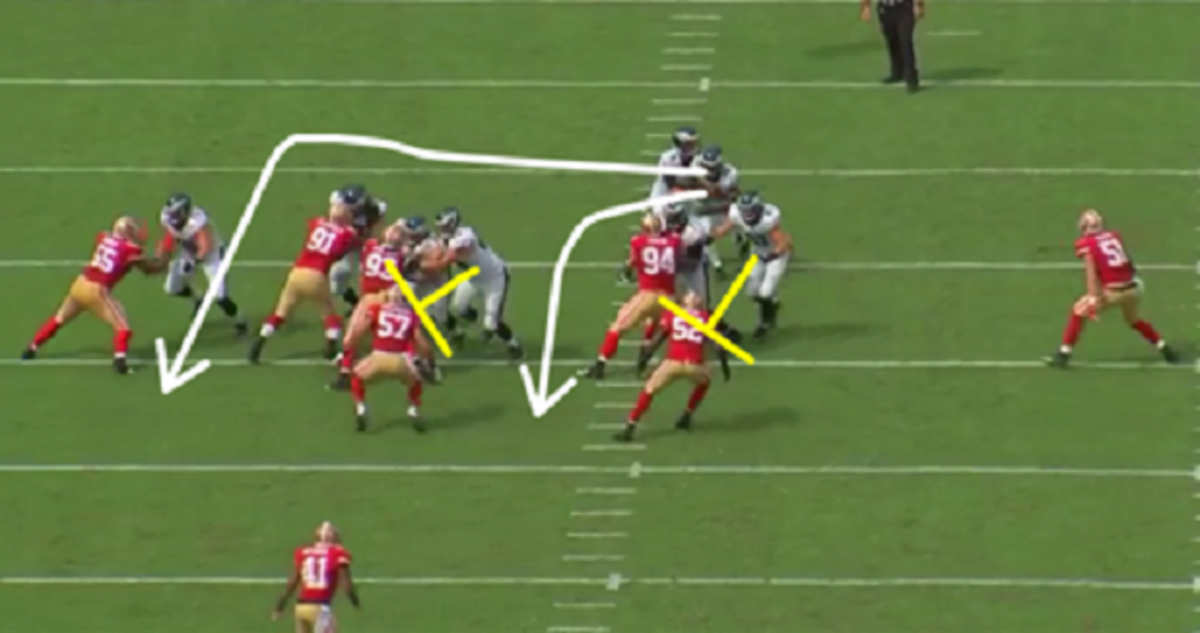
And then, in the blink of an eye, they were gone. The linemen responsible for Willis and Wilhoite both whiffed on their blocks, Ahmad Brooks (55) collapsed the edge to McCoy's right, and both Ray McDonald and Justin Smith drove their blockers back into McCoy's running lanes.
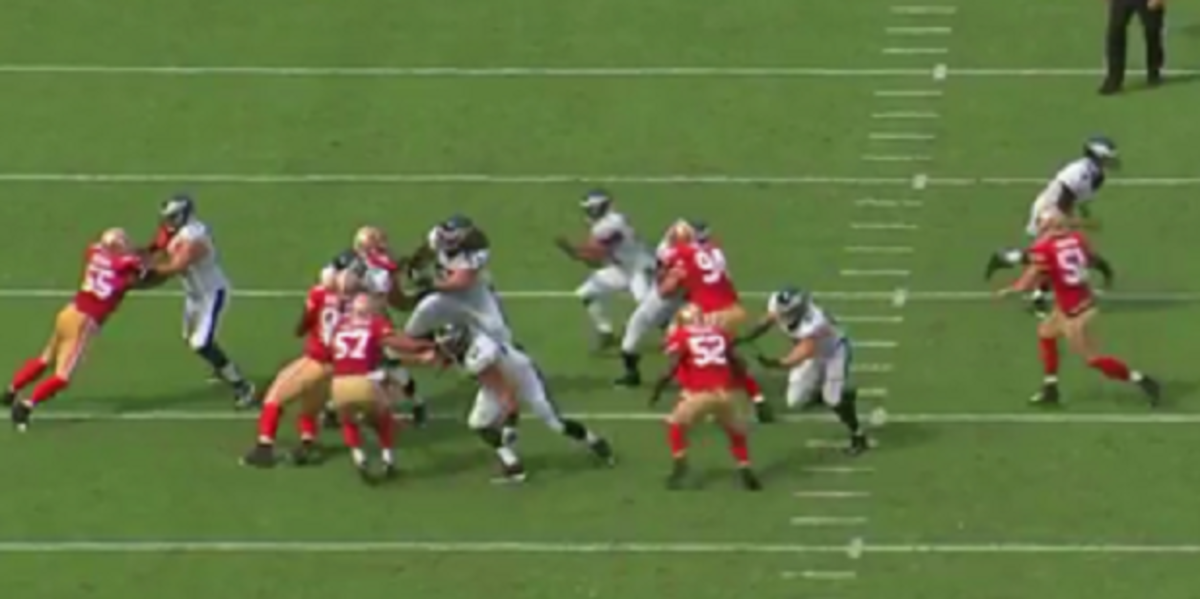
McCoy has been far from perfect in his reads, too often kicking outside in search of a bigger play -- here, for example, just driving up through that middle lane probably nets him a couple of yards, at least. But he's also finding himself in very tight spots before even getting to the line, which absolutely falls more on the Eagles' battered offensive line. St. Louis has not been stellar against the run so far, in part because of an injury to Chris Long, but the Rams have plenty of strength and speed up front to disrupt Philadelphia's blocking if it does not improve.
